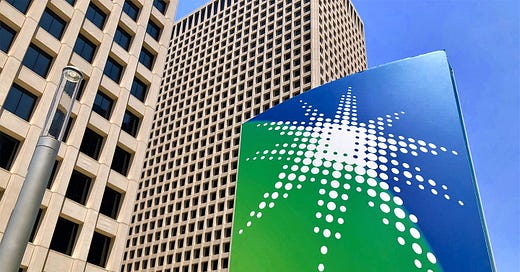Saudi Arabia suspends oil expansion as neighboring producers plan to raise output
The kingdom can still provide the world with an additional 1 MMbopd anyway
Source: Aramco, 2024.
Link: https://worldoil.com/magazine/2024/february-2024/columns/oil-and-gas-in-the-capitals/
Dr. Anas Alhajji / Contributing Editor, Middle East
On Jan. 29, Aramco announced that it had received a directive from the Saudi Energy Ministry to maintain its maximum sustainable capacity at 12 MMbopd. The state oil company said it “will update its capital spending guidance when its full-year 2023 results are announced in March.” The announcement was a clear sign that the kingdom was scrapping plans to increase oil capacity to 13 MMbopd.
The Recent Expansion Plan
Following the price war between Saudi Arabia and Russia in March 2020, the Saudi government ordered Aramco to revive an old plan to increase maximum sustainable capacity to 13 MMbopd. In mid-July 2022, and during U.S. President Joe Biden’s visit to the kingdom, Saudi Crown Prince Mohammed bin Salman addressed a U.S.-Arab summit, saying that his country was going to boost output capacity by 1 MMbopd: “The kingdom has announced an increase in its production capacity level to 13 MMbpd, after which the kingdom will not have any additional capacity to increase production.” The Saudi message back then was that the world’s largest oil exporter was doing its part to increase investment and secure global energy supplies, and that it won’t be responsible for any future energy shortages.
What Motivated Stoppage of the Expansion?
So, why then has Saudi Arabia decided to ditch its oil capacity expansion plans? Was the decision related to finances? Was it due to economics? Was it politics? Was it triggered by concerns about peak oil demand? Or was it due to climate change? Theoretically, the decision could have been driven by all these reasons.
In the oil market, a distinction must be made between production and supply. A country’s supply could be higher than, equal to or lower than output. For instance, producers can release oil from storage, making their supply higher than production, or they can store oil and keep supply lower. When it comes to the OPEC/OPEC+ oil quota, it is important to remember that it is based on production and not supply.
What if Saudi Arabia can add 1 MMbpd of supply to the oil market for years to come without having to increase production capacity by the same amount? In that case, the world will most likely be indifferent, because the global market would be supplied with 1 MMbopd anyway. For Saudi Arabia, however, this decision makes a big difference.
By switching investment to renewable energy and natural gas, Saudi Arabia can reduce domestic oil consumption, especially in the power sector, and redirect the freed-up oil amount to exports. The current development of Al Jafura tight gas field is expected to “play a key role” in the energy transition, which will reshape the energy landscape in the kingdom and also add a large amount of NGLs that will fulfill part of the global oil demand.
The Energy Minister’s Explanation
During the International Petroleum Technology Conference, in Dhahran, Saudi Arabia, on Feb. 12, Energy Minister Prince Abdulaziz bin Salman said the decision to halt oil capacity expansion was the result of energy transition: “I think we postponed this investment, simply because we’re transitioning. And transitioning means that even our oil company, which used to be an oil company, became a hydrocarbon company. Now it’s becoming an energy company.”
Neighboring countries remain committed to expansion
While Saudi Arabia has decided to pause its plans to increase oil capacity, the following OPEC members are heavily focused on raising their production capacity in the coming years:
Iran plans to increase oil production from 3.4 MMbpd to 4.0 MMbpd by the end of the fiscal year (March 20, 2024). The long-term objective is to increase production capacity to 5.7 MMbopd.
Iraq plans to increase its production capacity to 6 MMbopd by the end of 2027. This is an increase of 600,000 bopd above current capacity.
Kuwait plans to increase oil production capacity from the current 2.9 MMbpd to 3.2 MMbpd by 2025 or 2026. Kuwait’s long-term plan is to raise capacity to 4 MMbopd by 2035.
Qatar is developing the third phase of the offshore Al-Shaheen oil field, and this will increase production by 100,000 bopd by 2027.
The United Arab Emirates plans to increase its production capacity by 1 MMboopd to 5 MMbopd by 2027.
Final thoughts
To conclude, Saudi Arabia’s decision to halt expansion of its oil production capacity is not bullish and may not reflect a decline in global oil demand. The kingdom can still provide the world with an additional 1 MMbopd, if it replaces crude oil used in power plants with natural gas and directs the available oil amount to exports instead of consuming it domestically. Developing tight gas deposits will add a large amount of NGLs, which satisfies part of the global oil demand.
Meanwhile—and as neighboring producers are aiming to increase oil production capacity—it remains to be seen whether their projects will be delayed or canceled. In any case, we will see an increase in production capacity by 2027. But will it be enough to address growth in global oil demand?
***
About the Author
Dr. Anas Alhajji
Contributing Editor, Middle East
Dr. Anas Alhajji is an independent energy economist and the former chief economist at NGP Energy Capital Management. He is a well-known researcher, author, speaker, and award-winning academician and wood worker.





